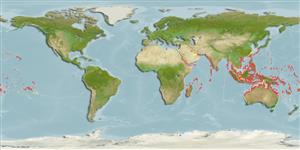>
Eupercaria/misc (Various families in series Eupercaria) >
Labridae (Wrasses) > Corinae
Etymology: Halichoeres: Greek, als, alis = salt + Greek, choiros = pig (Ref. 45335).
More on author: Rüppell.
Environment: milieu / climate zone / depth range / distribution range
البيئة
بحري مرتبطة بالشعاب; نطاق العمق 0 - 30 m (Ref. 1602). Tropical; 31°N - 33°S, 33°E - 124°W
Indo-Pacific: Red Sea south to Inhaca Island, Mozambique (Ref. 4392) and east to the Hawaiian (1 specimen) and Tuamoto islands, north to southern Japan, south to the southern Great Barrier Reef and Austral Islands.
Length at first maturity / الحجم / وزن / العمر
Maturity: Lm 7.0 range ? - ? cm
Max length : 18.0 cm TL ذكر/ مختلط الجنس; (Ref. 4392)
الأشواك الظهرية (المجموع): 9; الأشعة الظهرية الناعمة (المجموع): 13-14; شوكة شرجية 3; أشعه شرجية لينه: 12 - 13. Juveniles are black with numerous longitudinal white streaks (Ref. 1602).
Inhabit lagoon and seaward reefs, along the upper edges of coral-rich areas (Ref. 9710, 58534). Benthopelagic (Ref. 58302). May be solitary or found in small group (Ref. 90102). Juveniles are encountered in exposed outer reef flats (Ref. 1602). Feed on a wide variety of small invertebrates as well as fish eggs.
Life cycle and mating behavior
النضج | التكاثر | وضع البيض | بيض | الخصوبة | Larvae
Pelagic spawner. Females migrate to spawning sites, larger females travel long distances to downcurrent areas than smaller ones to protect the eggs from becoming prey to larger reef fishes (Ref. 32198). Spawning sites are chosen by the females irregardless of the males occupying them (Ref. 32198). Females spawn in more than one spawning site, each site occupied by more than one male, which are either territorial or non-territorial (Ref. 32198). After spawning, they return individually to their home ranges without passing through other spawning sites (Ref. 32198). Some females on the other hand change sex after spawning (Ref. 32198). As males, they begin to establish territories in the spawning sites, even to those they visited before the sex change (Ref. 32198). This observation support the suggestion (Warner's 1985, 1986) that females stored information on spawning sites by migrating to various sites which aided in the acquisition of a mating territory after changing sex (Ref. 32198).
Randall, J.E., G.R. Allen and R.C. Steene, 1990. Fishes of the Great Barrier Reef and Coral Sea. University of Hawaii Press, Honolulu, Hawaii. 506 p. (Ref. 2334)
IUCN Red List Status (Ref. 130435)
استخدامات بشرية
مصائد: غير مهمة تجارياً; حوض مائي: تجاري
مزيد من المعلومات
مراجعالأستزراع المائيملف الأستزراع المائيسلالاتجينيElectrophoresesالتوريثالأمراضمعالجةNutrientsMass conversion
المتعاونينصورStamps, Coins Misc.اصواتالتسمم باكل السمكسرعةنوع السباحةمنطقة الخياشيمعظمة الأذندماغرؤية
أدوات
تقارير خاصة
Download XML
مصادر علي الأنترنت
Estimates based on models
Preferred temperature (Ref.
123201): 25 - 29.3, mean 28.3 °C (based on 3073 cells).
Phylogenetic diversity index (Ref.
82804): PD
50 = 0.5000 [Uniqueness, from 0.5 = low to 2.0 = high].
Bayesian length-weight: a=0.01047 (0.00607 - 0.01808), b=3.16 (3.01 - 3.31), in cm total length, based on LWR estimates for this species & Genus-body shape (Ref.
93245).
مستوى غذائي (Ref.
69278): 3.2 ±0.2 se; based on diet studies.
Generation time: 1.5 ( na - na) years. Estimated as median ln(3)/K based on 1
growth studies.
المرونه (Ref.
120179): عالي, الحد الزمني الأدني لتضاعف عدد أفراد المجتمع أقل من 15 شهر (K=0.7).
Fishing Vulnerability (Ref.
59153): Low vulnerability (20 of 100).
Nutrients (Ref.
124155): Calcium = 89.3 [53.4, 149.2] mg/100g; Iron = 0.784 [0.460, 1.420] mg/100g; Protein = 18.5 [15.6, 20.7] %; Omega3 = 0.15 [0.10, 0.23] g/100g; Selenium = 27 [17, 48] μg/100g; VitaminA = 101 [33, 373] μg/100g; Zinc = 1.73 [1.21, 2.74] mg/100g (wet weight);
